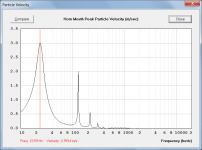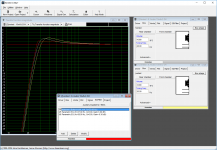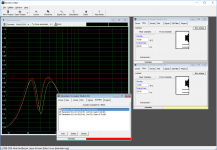I have (4) JL 10w6v2-D4 subs I'd like to use in my setup in 2 separate enclosures.
Room is 14.5' wide, 26' long, and 7.5' tall. Acoustic tiles in ceiling. Corner bass traps going in shortly as well as absorbing panels at first reflection points.
Marantz SR7010 receiver in 7.2.4
(2) QSC RMX1450 for sub amps.
Boston M series towers, center, and surrounds on wall. HSi in ceiling for Atmos.
50% of the time we watch movies, 50% is for 2 channel music.
WinISD recommends a 4.25 cu ft box with a tuning so far below the driver's fs I couldn't get the cone excursion under control with a hp filter.
I've modelled both a 4.25 ft box at 24hz (hp 4th order butterworth @ 21hz) and a 3 ft box at 30hz (hp 4th order butterworth @ 24hz). Cone excursion is at 1000w (500w ea) See attached.
I know this isn't a 15 so it's not ever going to get massive spl at lower freqs.
Suggestions? Comments?
Room is 14.5' wide, 26' long, and 7.5' tall. Acoustic tiles in ceiling. Corner bass traps going in shortly as well as absorbing panels at first reflection points.
Marantz SR7010 receiver in 7.2.4
(2) QSC RMX1450 for sub amps.
Boston M series towers, center, and surrounds on wall. HSi in ceiling for Atmos.
50% of the time we watch movies, 50% is for 2 channel music.
WinISD recommends a 4.25 cu ft box with a tuning so far below the driver's fs I couldn't get the cone excursion under control with a hp filter.
I've modelled both a 4.25 ft box at 24hz (hp 4th order butterworth @ 21hz) and a 3 ft box at 30hz (hp 4th order butterworth @ 24hz). Cone excursion is at 1000w (500w ea) See attached.
I know this isn't a 15 so it's not ever going to get massive spl at lower freqs.
Suggestions? Comments?
Attachments
Driver specs? If recommended tuning is much < Fs, then a sealed or TL alignment is called for.
GM
GM
Parameters:
Free Air Resonance (Fs) 28.5 Hz
Electrical “Q” (Qes) 0.497
Mechanical “Q” (Qms) 8.458
Total Speaker “Q” (Qts) 0.469
Equivalent Compliance (Vas) 1.18 cu ft / 33.4 L
One-Way Linear Excursion (Xmax)* 0.60 in / 15 mm
Reference Efficiency (no) 0.15%
Efficiency (1 W / 1 m)** 83.7 dB SPL
Effective Piston Area (Sd) 51.4 sq in / 0.0332 sq m
DC Resistance (Re)*** 6.3 Ω (Series)
Sealed is a distant option, but the response rolls off super early (down 3db at 45hz...) I'd prefer to stay ported if the gods allow.
Free Air Resonance (Fs) 28.5 Hz
Electrical “Q” (Qes) 0.497
Mechanical “Q” (Qms) 8.458
Total Speaker “Q” (Qts) 0.469
Equivalent Compliance (Vas) 1.18 cu ft / 33.4 L
One-Way Linear Excursion (Xmax)* 0.60 in / 15 mm
Reference Efficiency (no) 0.15%
Efficiency (1 W / 1 m)** 83.7 dB SPL
Effective Piston Area (Sd) 51.4 sq in / 0.0332 sq m
DC Resistance (Re)*** 6.3 Ω (Series)
Sealed is a distant option, but the response rolls off super early (down 3db at 45hz...) I'd prefer to stay ported if the gods allow.
Attachments
Your box sizes seem far yoo large. I've implemented 27hz tuning in 1.5 cubic feet internal with this driver
1 driver, for use in car but this still offered optimum 2 pi response. I will dig up the sketchup if I still have it
1 driver, for use in car but this still offered optimum 2 pi response. I will dig up the sketchup if I still have it
Well, the yellow plot is 3 cu ft for 2 drivers. I'll try lowering from 30Hz to 27hz and see.
Well, a low mach vent is so large that I opted for a mildly stuffed TQWT that you can fold in half to put the drivers, vent next to the floor for max loading, so is ~176 L tuned in the low 20s [box + vent morphed into an inverse tapered pipe].
Load the file into Hornresp to view all the particulars.
GM
Load the file into Hornresp to view all the particulars.
GM
Attachments
Well, a low mach vent is so large that I opted for a mildly stuffed TQWT that you can fold in half to put the drivers, vent next to the floor for max loading, so is ~176 L tuned in the low 20s [box + vent morphed into an inverse tapered pipe].
Load the file into Hornresp to view all the particulars.
GM
Gm, what's the horn exit velocity look like on that?
I know from experience it will be < 10% and probably down around 5%, especially if damped with acoustic FG insulation, but for now, don't have any program loaded to sim it.
GM
GM
what's the horn exit velocity look like on that?
If there is no absorbent filling material in the transmission line, the velocity will be as shown below.
Attachments
Hmm, this option is 'whited out' regardless of whether or not it's 'masked' and/or has no filling........... 🙁
GM
GM
Hmmm... I don't really have any experience with TL's or horns...
I was wanting to go ported, but I'm kinda interested now in that TL. Is that model for 1 or 2 woofers?
I was wanting to go ported, but I'm kinda interested now in that TL. Is that model for 1 or 2 woofers?
transmission line is likely a great option i'm just curious how much compression GMS example will present at resonance when the box is driven to its limits.
Two.
Again, view it as a 'streamlined' box + vent that has been converted into an inverse tapered horn. Obviously, you can accomplish a similar response with a large vent reflex, but you don't get the quantity, quality of bass since to smooth out its response enough in its desired pass-band the vent has to be stuffed, same as the TQWT, but in this case [alignment] it also reduces the amount of bass it can output at a low vent mach since it has no horn loading to offset it.
Bottom line, anytime a vented alignment requires a long, large vent, better to convert it to a TQWT and in some cases to a back loaded horn [BLH] AKA big vent reflex [BVR].
GM
Again, view it as a 'streamlined' box + vent that has been converted into an inverse tapered horn. Obviously, you can accomplish a similar response with a large vent reflex, but you don't get the quantity, quality of bass since to smooth out its response enough in its desired pass-band the vent has to be stuffed, same as the TQWT, but in this case [alignment] it also reduces the amount of bass it can output at a low vent mach since it has no horn loading to offset it.
Bottom line, anytime a vented alignment requires a long, large vent, better to convert it to a TQWT and in some cases to a back loaded horn [BLH] AKA big vent reflex [BVR].
GM
transmission line is likely a great option i'm just curious how much compression GMS example will present at resonance when the box is driven to its limits.
Historically, driver thermal power compression significantly reduces the TQWT's vent resistance, so a < 4:1 CR is normally sufficient to 'open up' down around/at Fp, though some of the new high end drivers with mega power handling at low TPC would be a different story altogether. They would ideally need compression horns.
GM
edit: If one prefers, a S3 = 332 cm^2 [2:1 CR] with the same S1 = 2000 cm^2 would be ~218 cm long.
Last edited:
I haven't had time to play with the TL, but I modelled another box based on some vented suggestions.
The red plot is 3cuft tuned to 27Hz. Highpass Butterworth, 4th order @ 23Hz
I also added on a couple parametric EQ's:
-27Hz, Q=6, Gain = 3db
-38Hz, Q=6, Gain = -0.3db
I've never played with parametric EQ's. Is this a bad idea? It extended the low frequencies and controlled the cone excursion.
I'll experiment with some TL modelling next.
Thanks!
The red plot is 3cuft tuned to 27Hz. Highpass Butterworth, 4th order @ 23Hz
I also added on a couple parametric EQ's:
-27Hz, Q=6, Gain = 3db
-38Hz, Q=6, Gain = -0.3db
I've never played with parametric EQ's. Is this a bad idea? It extended the low frequencies and controlled the cone excursion.
I'll experiment with some TL modelling next.
Thanks!
Attachments
Hmm, this option is 'whited out' regardless of whether or not it's 'masked' and/or has no filling........... 🙁
Hi GM,
That's because you are looking at the combined output of the system. Select either Tools > Output > Horn or Tools > Output > Direct Radiator to enable the Sound Pressure and Particle Velocity menu commands.
If you check the Sound Pressure and Particle Velocity sections in the Hornresp Help file, you will see that they do say "Not applicable to combined outputs" 🙂.
Kind regards,
David
Greets!
Thanks, though I did read the HELP File and it didn't work and after you posted that it didn't include any damping and it still didn't work, I didn't care. I guess when I transferred HR from a BU HDD to this computer something got lost in the 'translation'.
Regardless, I updated the program and it works now without having to delete 'masked' and/or damping in the Wizard, though ATM can't think of any need for it without it factoring them in.
GM
Thanks, though I did read the HELP File and it didn't work and after you posted that it didn't include any damping and it still didn't work, I didn't care. I guess when I transferred HR from a BU HDD to this computer something got lost in the 'translation'.
Regardless, I updated the program and it works now without having to delete 'masked' and/or damping in the Wizard, though ATM can't think of any need for it without it factoring them in.
GM
Am I seeing this correct? 6 cu ft volume for 2 drivers? That might be a tough sell with the wife when I build 2 of them....
Anybody have any comments on my question about parametric eq's? Am I on the right track or completely off the rails?
Anybody have any comments on my question about parametric eq's? Am I on the right track or completely off the rails?
- Status
- Not open for further replies.
- Home
- Loudspeakers
- Subwoofers
- JL Audio 10w6V2 enclosure design
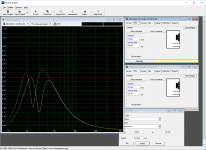
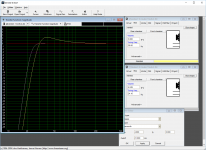
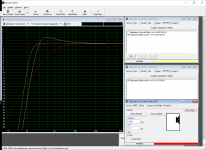
![JL Audio 10w6V2-D4 ML-TQWT [series VCs] dual.PNG](/community/data/attachments/484/484947-60e3dffe6338e011eec38d6be9bb037f.jpg?hash=YOPf_mM44B)
![JL Audio 10w6V2-D4 ML-TQWT [series VCs] dual response plot.PNG](/community/data/attachments/484/484953-4f7182e93b44875627798340ed08a1b8.jpg?hash=T3GC6TtEh1)
